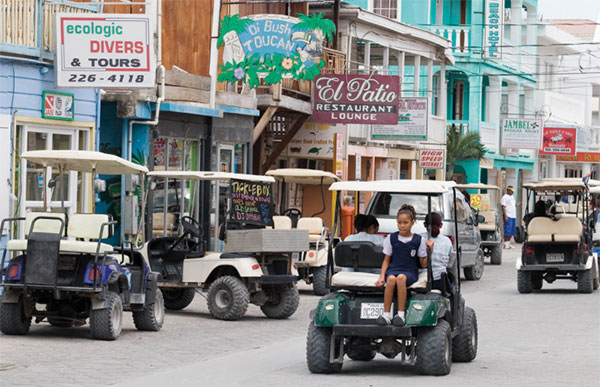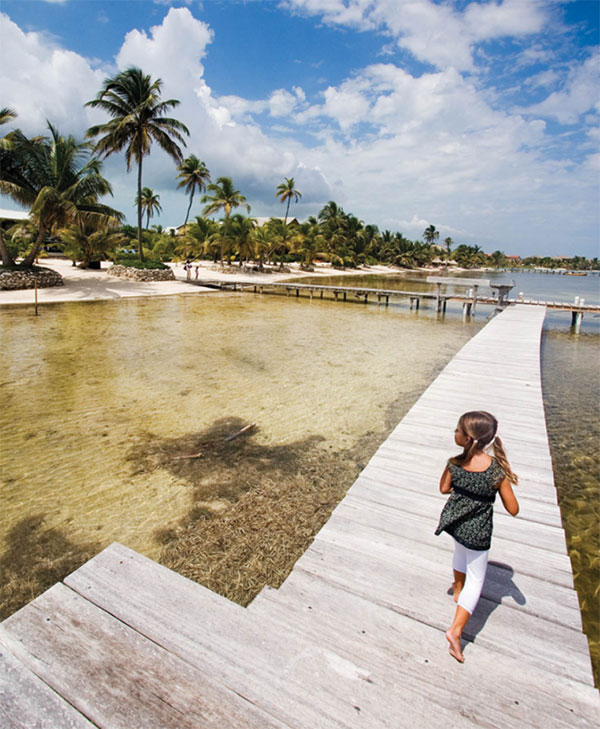Fact
Ambergris Caye is thought to have gained its name when quantities of ambergris (a substance secreted by sperm whales), appeared on its shores during the 19th century.
San Pedro
In the early 1980s, fishing was still the major industry at San Pedro – which is why the town and church were named after St Peter. Now many of the fishermen use their locally-made mahogany boats to take tourists to the Barrier Reef that parallels the island. But although this is the most touristy part of Belize, the population is still only 5,000. If you like your tourism slick and well-orchestrated, with raging nightclubs and elegant dining, this may not be the place for you. The allure of San Pedro and the caye is its low-key charm, flanked by its stunning setting.
The heart of town is midway along Barrier Reef Drive. On one block, there is the Town Hall and police station. On the next block is San Pedro Church, an airy building whose large windows have jalousies so that the congregation can be cooled by the Caribbean breeze. On the breezy beachfront several miles north and south of San Pedro, numerous luxury resorts have been built over the last decade – with new resorts regularly popping up. Even so, life on Ambergris is still pretty mellow, and going barefoot is appropriate just about anywhere. This relaxed atmosphere has attracted more than a few resident North Americans, who now run hotels, gift shops, and restaurants. Directly down on the beach from here is the center of the caye’s nightlife.
North of town is the Boca del Rio, known locally as The River: a bridge joins the town to the northern part of the island, where a rugged dirt road leads to the tiny village of Tres Cocos and the northern resorts that lie on beautiful, though largely deserted, beaches. There are no towns here, so activity centers around several resorts and some good restaurants.

Golf carts along San Pedro’s high street.
Corrie Wingate/Apa Publications
The lagoon side of Ambergris Caye has long been overlooked, with just a few restaurants and untamed swathes of land that hold pockets of residential homes. But, with the completion of the ambitious San Pedro Sunset Boardwalk and Water Taxi Terminal in 2014, which became fully operational in 2016, that’s beginning to change. Although many boats and water taxis still pull up on the reef side, it is hoped that the new terminal will increase traffic to the lagoon in the future.
South of San Pedro
Ambergris Caye owes much of its physical existence to the mangrove, which can be most easily seen to the south, following the sand road from the airport. Untouched except for the occasional plastic wrapping or old shoe washed in by the gentle waves, the mangrove swamp is like a trip into the womb that gave birth to the island.
South of San Pedro, the beachfront is dotted with a number of rustic-chic resorts, such as the eco-friendly Xanadu Island Resort (www.xanaduislandresort.com) as well as the luxurious colonial-style Victoria House (www.victoria-house.com). Plenty of outdoor bars liven up the evenings.
The longest Barrier Reef in the Western Hemisphere
Like any other self-respecting tropical island, Ambergris Caye looks to the sea. The island is set in the Barrier Reef, and it is offshore that one heads for swimming, fishing, diving, and snorkeling. Most of the water between the coast and the reef is shallow and grassy – a shoreline for lounging, not surfing. It was the Maya who discovered a natural cut in the reef, which attracted a wide range of marine life. They called it ‘Hol Chan,’ Little Channel. In 1987, the area around the cut was declared the Hol Chan Marine Reserve – only 10 minutes away by boat, it is Ambergris’ principal local site for snorkeling and scuba diving.
Shark Ray Alley
While San Pedro is the ideal base if you’re planning to visit Hol Chan, many dive and snorkel operators from Caye Caulker will also take you there. Snorkeling along the reef is fun, but the truly adventurous will want to take the plunge at Shark Ray Alley. This is only 2km (1 mile) south of Hol Chan and offers the unique experience of diving or snorkeling with stingrays and nurse sharks. Although they seem fairly harmless (but don’t look that way at feeding time) this is not a swim for the fainthearted. You may jump into the water fairly confident but suddenly start feeling a little nervous when the wings of the ray brush against you or a shark races by. You can only visit Shark Ray Alley with an experienced guide.

El Pescador resort, south of San Pedro.
Corrie Wingate/Apa Publications
The Blue Hole
Lying just 11km (7 miles) north of Half Moon Caye is one of the world’s most famous dive sites – and a stunning natural wonder: the Blue Hole.
Looking from the air like a dark blue pool in a field of turquoise, the site gained fame in 1972 when Jacques Cousteau maneuvered his ship Calypso through narrow coral channels to moor and film inside. The Blue Hole is actually a sinkhole created by a collapsed underground cavern; over 300 meters (980ft) across and 135 meters (445ft) deep, with huge stalactites hanging from offshoot caves at depths of 30–45 meters (100−150ft).
While there is not much marine life in this vivid blue shaft of water, the geological formations and encircling coral are spectacular. Sharks and turtles abound in the waters around the Blue Hole, though their presence is rarely predictable. This dive is usually reserved for the more adventurous and experienced, under the strict supervision of a dive master. It is definitely not a plunge to be attempted by the novice.
The Belize Audubon Society and the Forestry Department manage the Blue Hole Natural Monument at Lighthouse Reef, which covers an area of 414 hectares (1,023 acres), with the Blue Hole at the center.
Caye Caulker
‘Go slow’ is the motto on Caye Caulker 6 [map] , and after a few days ambling its sunny shores, you’ll understand why. The great appeal of Caye Caulker is the loose and languid rhythm – wake up late, take a leisurely sail, then a dip in the water, and finally ease into the evening with a chilled Belikin in hand and toes in the warm sand as the sun sinks into the Caribbean Sea.
This working fishing village was originally settled by mestizos (of mixed Spanish and Indigenous blood) fleeing the Caste War in Mexico’s Yucatán in the mid-19th century; today it has about 1,500 year-round residents, mostly of mestizo descent. The population swells considerably on weekends and holidays, when hundreds of Belize City residents descend on the island’s small guesthouses and hotels. The winter holidays and Easter are the busiest seasons, so it’s well worth making reservations in advance, though you can usually still find a few basic spots with rooms available even at the last minute.